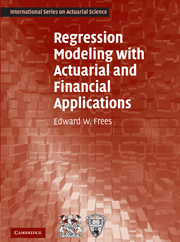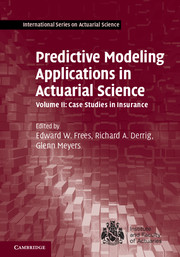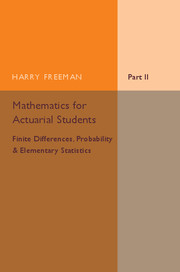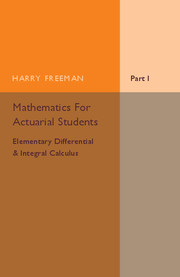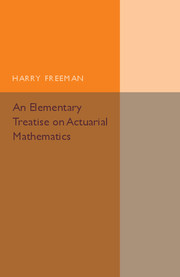Regression Modeling with Actuarial and Financial Applications
This text gives budding actuaries and financial analysts a foundation in multiple regression and time series. They will learn about these statistical techniques using data on the demand for insurance, lottery sales, foreign exchange rates, and other applications. Although no specific knowledge of risk management or finance is presumed, the approach introduces applications in which statistical techniques can be used to analyze real data of interest. In addition to the fundamentals, this book describes several advanced statistical topics that are particularly relevant to actuarial and financial practice, including the analysis of longitudinal, two-part (frequency/severity), and fat-tailed data. Datasets with detailed descriptions, sample statistical software scripts in 'R' and 'SAS', and tips on writing a statistical report, including sample projects, can be found on the book's Web site: http://research.bus.wisc.edu/RegActuaries.
- Provides a link between data analysis and data modelling - explains the role of a model
- Easy for a first time instructor - many real world data sets included, and a technical appendix provides the instructor with a great deal of flexibility for course coverage
- Contains many references to different sub-disciplines within the broad field of actuarial science, risk management and finance
Reviews & endorsements
'It would be an ideal text for a semester - or a year-long course in applied statistical methods for actuarial science majors. But it would also be a welcome addition to the bookshelf of pracitcing actuaries at all levels, both actuarial students charged with conducting analyses for which the methods discussed in the book are most relevant, and senior managers who use such analysis as a basis for financial decision making … Perhaps my favorite part of Fee's book is the final two chapters, on Report Writing and Designing Effective Graphs. If these fine essays do not already appear somewhere on the Society of Actuaries syllabus, they should be added immediately.' Ronald C. Neath, The American Statistician
Product details
November 2009Paperback
9780521135962
584 pages
248 × 174 × 30 mm
0.95kg
139 b/w illus. 142 tables 89 exercises
Available
Table of Contents
- 1. Regression and the normal distribution
- Part I. Linear Regression:
- 2. Basic linear regression
- 3. Multiple linear regression - I
- 4. Multiple linear regression - II
- 5. Variable selection
- 6. Interpreting regression results
- Part II. Topics in Time Series:
- 7. Modeling trends
- 8. Autocorrelations and autoregressive models
- 9. Forecasting and time series models
- 10. Longitudinal and panel data models
- Part III. Topics in Nonlinear Regression:
- 11. Categorical dependent variables
- 12. Count dependent variables
- 13. Generalized linear models
- 14. Survival models
- 15. Miscellaneous regression topics
- Part IV. Actuarial Applications:
- 16. Frequency-severity models
- 17. Fat-tailed regression models
- 18. Credibility and bonus-malus
- 19. Claims triangles
- 20. Report writing: communicating data analysis results
- 21. Designing effective graphs
- Appendix 1: basic statistical inference
- Appendix 2: matrix algebra
- Appendix 3: probability tables.

